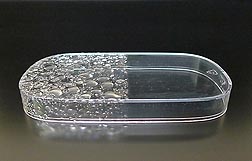This page has been archived and is being provided for reference purposes only. The page is no longer being updated, and therefore, links on the page may be invalid.
| Read the magazine story to find out more. |
|
|
Nanoparticle-based Coating Helps Stop Water from Beading
By Marcia Wood
June 30, 2014
Rainwater pounding on the glass windows of an office building or a home is less likely to bead up and reduce visibility if the windows are treated with a new, transparent coating from U.S. Department of Agriculture (USDA) chemist Sanghoon Kim and his colleagues.
Besides its potential use on windows, the coating might also be applied to solar panels to help keep dirt from interfering with their performance, Kim notes.
What's more, Kim and his colleagues have observed that the coating works well on other materials, including Plexiglas and metals such as stainless steel.
Kim, along with research chemist Atanu Biswas and physical scientist Kervin Evans—all with the USDA Agricultural Research Service (ARS) National Center for Agricultural Utilization Research in Peoria, Illinois—created the coating's nanoparticles by using only a few off-the-shelf laboratory chemicals, including a protein from agriculture.
From start to finish, production of the nanoparticles takes less than an hour, involves simple procedures with inexpensive chemicals, and doesn't require specialized equipment or costly heating.
In a proof-of-concept experiment, the researchers used bovine serum albumin, which is a cattle industry byproduct, as the protein, and ethyl cyanoacrylate, a major component of "super glue," as the starting material that is key to creating the nanoparticles.
Applying the coating is quick and easy. All that's needed is to spray it onto clean glass or other recommended surfaces, then rinse with water.
In a follow-up study, Kim and his colleague Yeon Seok Kim of the National Institute of Standards and Technology, used gliadin, a protein from wheat, to demonstrate that their process for making the coating is applicable to both plant- and animal-derived proteins.
Peer-reviewed scientific articles published this year in the Journal of Nanoparticle Research and in 2013 in Colloids and Surfaces B: Biointerfaces have details about the work.
Informal cost estimates suggest that the new coating, made with either a plant or an animal protein, could be produced at the same or less cost than coatings already on the market.
The Peoria coating is rain-ready in about a minute, a feature that apparently makes it unique. ARS is seeking a patent for the research; the scientists are looking for industry partners to commercialize it.
Read more in the May/June 2014 issue of Agricultural Research magazine.
ARS is the USDA's chief intramural scientific research agency.

